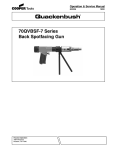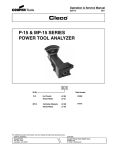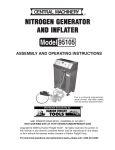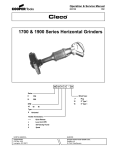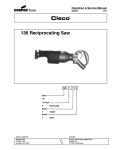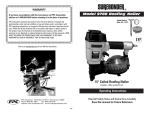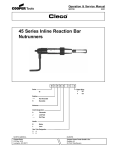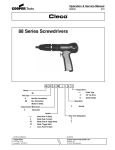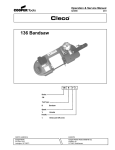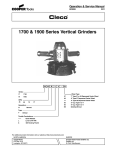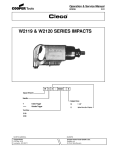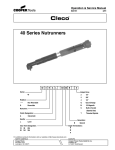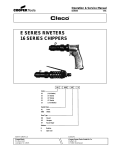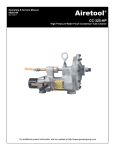Download 135DPV-B Series Variable Speed Drills
Transcript
Operation & Service Manual 823040 2/01 135DPV-B Series Variable Speed Drills 135 D PV - XX B - XX Series: 135 Drill: 42 43 50 51 Drill Chuck: (3/8-24B) 1/4 HD Capacity (3/8-24B) 3/8 HD Capacity (3/8-24B) 1/2 Capacity (3/8-24B) 3/8 Capacity 40 No Chuck (3/8-24B) Handle: PV Pistol (Variable Speed) Generation: B Second Gear Train Designation: 7 14 28 NORTH AMERICA EUROPE CooperTools P.O. Box 1410 Lexington, SC 29071 Cooper Power Tools GmbH & Co. Postfach 30 D-73461 Westhausen 1 Safety Recommendations For your safety and the safety of others, read and understand the safety recommendations and operating instructions before operating a drill. Always wear protective equipment: ! ventilation and/or wear a respirator. Respirators should be selected, fitted, used and maintained in accordance with Occupational Safety and Health Administration and other applicable regulations. Read the material safety data sheet of any cutting fluids or materials involved in the drilling process. WARNING ! WARNING Impact resistant eye protection must be worn while operating or working near this tool. For additional information on eye protection and face protection, refer to Federal OSHA Regulations, 29 Code of Federal Regulations, Section 1910.133., Eye and Face Protection, and American National Standards Institute, ANSI Z87.1, Occupational and Educational Eye and Face Protection. Z87.1 is available from the American National Standards Institute, Inc., 11 West 42nd Street, New York, NY 10036. ! Do not wear loose fitting clothes, long hair, gloves, ties or jewelry. CAUTION Personal hearing protection is recommended when operating or working near this tool. Hearing protection is recommended in high noise areas 85 dBA or greater. The operation of other tools and equipment in the area, reflective surfaces, process noises and resonant structures can substantially contribute to, and increase the noise level in the area. Excessive air pressure above 90 PSIG or worn motor components can also increase sound level emitted by tool. Proper hearing conservation measures, including annual audiograms and training in the use and fit of hearing protection devices may be necessary. For additional information on hearing protection, refer to Federal Regulations, Section 1910.95, Occupational Noise Exposure, and American National Standards Institute, ANSI S12.6, Hearing Protectors. Cleco drills are designed to operate on 90 psig (6.2 bar) maximum air pressure. If the tool is properly sized and applied, higher air pressure is unnecessary. Excessive air pressure increases the loads and stresses on the tool parts and may result in breakage. Installation of a filterregulator-lubricator in the air supply line ahead of the tool is recommended. Before the tool is connected to the air supply, check the throttle for proper operation (i. e., throttle moves freely and returns to closed position). Being careful not to endanger adjacent personnel, clear the air hose of accumulated dust and moisture. Before removing a tool from service or changing a drill bit, tap, reamer, or any accessory make sure the air line is shut off and drained of air. This will prevent the tool from operating if the throttle is accidently engaged. Sudden and high reaction torque may be experienced with any drill if: • drill motor stalls by excessive load being applied to drill bit or drill bit snags on material being drilled. • on break-through when the drill bit passes through the material being drilled. User must be prepared to resist torque. ! ! WARNING Wear respirator where necessary. Drilling operations may produce hazardous fumes and/or dust. To avoid adverse health effects utilize adequate 2 Follow good machine shop practices. Rotating shafts and moving components can entangle and entrap, and can result in serious injuries. Never wear long hair, loose-fitting clothes, gloves, ties, or jewelry when working with or near a drill of any type. CAUTION Safety Recommendations ! CAUTION • Drill bits are sharp. Handle them carefully to avoid injury. • Cutting tool maximum speed rating must equal or exceed rated speed of tool. • Drill bits or accessories not centered properly in the chuck can cause excessive wobble or vibration. • Use appropriately sized chuck key to securely tighten drill bit, tap, or reamer in drill chuck. Always remove chuck key before starting tool. • Use care when drilling because of the possibility of the cutting tool bending or breaking. ! CAUTION Tools equipped with chuck capacity over 1/4" should have at least one handle offset at a right angle to drill axis to counteract torque developed by tool. If tool is equipped with a chuck over 3/8" capacity, two handles at right angles to the drill axis should be used. One handle should contain the tool throttle, such as pistol grip or offset handle models. Always use a dead handle with low RPM — high torque tools. ! WARNING Repetitive work motions and/or vibration may cause injury to hands and arms. Use minimum hand grip force consistent with proper control and safe operation. Keep body and hands warm and dry. Avoid anything that inhibits blood circulation. Avoid continuous vibration exposure. Keep wrists straight. Avoid repeated bending of wrists and hands. Some individuals may be susceptible to disorders of the hands and arms when performing tasks consisting of highly repetitive motions and/or exposure to extended vibration. Cumulative trauma disorders such as carpal tunnel syndrome and tendonitis can be caused or aggravated by repetitious, forceful exertions of the hands and arms. Vibration may contribute to a condition called Raynaud's Syndrome. These disorders develop gradually over periods of weeks, months, and years. It is presently unknown to what extent exposure to vibrations or repetitive motions may contribute to the disorders. Hereditary factors, vasculatory or circulatory problems, exposure to cold and dampness, diet, smoking and work practices are thought to contribute to the conditions. Any tool operator should be aware of the following warning signs and symptoms so that a problem can be addressed before it becomes a debilitating injury. Any user suffering prolonged symptoms of tingling, numbness, blanching of fingers, clumsiness or weakened grip, nocturnal pain in the hand, or any other disorder of the shoulders, arms, wrists, or fingers is advised to consult a physician. If it is determined that the symptoms are job related or aggravated by movements and postures dictated by the job design, it may be necessary for the employer to take steps to prevent further occurrences. These steps might include, but are not limited to, repositioning the workpiece or redesigning the workstation, reassigning workers to other jobs, rotating jobs, changing work pace, and/or changing the type of tool used so as to minimize stress on the operator. Some tasks may require more than one type of tool to obtain the optimum operator/ tool/task relationship. The following suggestions will help reduce or moderate the effects of repetitive work motions and/or extended vibration exposure: • Use a minimum hand grip force consistent with proper control and safe operation • Keep body and hands warm and dry (cold weather is reported to be a major factor contributing to Raynaud's Syndrome) • Avoid anything that inhibits blood circulation —Smoking Tobacco (another contributing factor) —Cold Temperatures —Certain Drugs • Tasks should be performed in such a manner that the wrists are maintained in a neutral position, which is not flexed, hyperextended, or turned side to side. Avoid Extension OK Neutral Avoid Flexion Avoid Radial Deviation OK Avoid Neutral Ulnar Deviation • Stressful postures should be avoided — select a tool appropriate for the job and work location • Avoid highly repetitive movements of hands and wrists, and continuous vibration exposure (after each period of operation, exercise to increase blood circulation) • Keep tool well maintained and replace worn parts 3 Safety Recommendations WARNING ! OVER Repetitive work motions and/or vibration can cause injury to hands and arms. Use minimum hand grip force consistent with proper control and safe operation. Keep body and hands warm and dry. Avoid anything that inhibits blood circulation. Avoid continuous vibration exposure. Keep wrists straight. Avoid repeated bending of wrists and hands. CAUTION ! Personal hearing protection is recommended when operating or working near this tool. WARNING Hearing protection is recommended in high noise areas (above 85 dBA). Close proximity of other tools, reflective surfaces, process noises, and resonant structures can substantially contribute to the sound level experienced by the user. 203185 ! 203185-4 Impact resistant eye protection must be worn while operating or working near this tool. READ OPERATING INSTRUCTIONS Read Operating Instructions carefully. Follow the Safety Recommendations for your safety and the safety of others. Warning Labels The warning labels found on these tools are an essential part of this product. Labels should not be removed. Labels should be checked periodically for legibility. Replace warning labels when missing or when the information can no longer be read. Replacement labels can be ordered as any spare part. Do not remove this tag until the operator of this tool has read these safety precautions. Work gloves with vibration reducing liners and wrist supports are available from some manufacturers of industrial work gloves. Tool wraps and grips are also available from a number of different manufacturers. These gloves, wraps, and wrist supports are designed to reduce and moderate the effects of extended vibration exposure and repetitive wrist trauma. Since they vary widely in design, material, thickness, vibration reduction, and wrist support qualities, it is recommended that the glove, tool wrap, or wrist support manufacturer be consulted for items designed for your specific application. WARNING! Proper fit of gloves is important. Improperly fitted gloves may restrict blood flow to the fingers and can substantially reduce grip strength. 203287 This information is a compilation of general safety practices obtained from various sources available at the date of production. However, our company does not represent that every acceptable safety practice is offered herein, or that abnormal or unusual circumstances may not warrant or require additional procedures. Your work may require additional specific safety procedures. Follow these procedures as required by your company. For more information, see the latest edition of ANSI B186.1, Safety Code for Portable Air Tools, available from the American National Standards Institute, Inc., 11 West 42nd Street, New York, NY 10036. 4 OPERATING INSTRUCTIONS FOR YOUR SAFETY AND THE SAFETY OF OTHERS READ AND UNDERSTAND THE SAFETY RECOMMENDATIONS ON PAGES 2 thru 4 BEFORE OPERATING A DRILL. OPERATION LUBRICATION The 135DPV-B series drills are designed to operate on 90 PSIG (6.2 bar) air pressure. The 135-B series requires a 5/ 16" hose. An automatic in-line filter-lubricator is recommended as it increases tool life and keeps the tool in sustained operation. The in-line lubricator should be regularly checked and filled with a good grade of 10W machine oil. Proper adjustment of the in-line lubricator is performed by placing a sheet of paper next to the exhaust ports and holding the throttle open approximately 30 seconds. The lubricator is properly set when a light stain of oil collects on the paper. Excessive amounts of oil should be avoided. The drill is started by depressing the trigger and is stopped by releasing the trigger. SPEED ADJUSTMENT Adjustment of the speed is done by depressing the indexing blade and rotating the speed adjustment cap to the desired RPM. In the event that it becomes necessary to store the tool for an extended period of time (overnight, weekend, etc.), it should receive a generous amount of lubrication at that time and again when returned to service. The tool should be stored in a clean and dry environment. SPEED ADJUSTING CAP 250 INDEX BLADE TRIGGER 5 SERVICE INSTRUCTIONS — DISASSEMBLY DISASSEMBLY Insert a hex wrench into the drill chuck and tighten the chuck securely. Use a suitable hammer to strike the hex wrench sharply in a counter- clockwise direction when facing the chuck. Remove the drill chuck from the spindle. Unscrew (left hand threads) the bearing retainer, No. 202031 (or chuck guard) from the gear case. GEAR TRAIN DISASSEMBLY Unscrew (left hand threads) the spindle bearing retainer No. 202031. The spindle may now be pressed out of the spindle bearings. If replacement of the idler gear pins is necessary, the old pins should be pressed out the rear and the replacement pins pressed in as shown in the following diagrams. .240 (6.10mm) .255 (6.48mm) Front Rear Unscrew and remove the gear case from the handle. Remove the rotational stop set screw, No. 864193, and unscrew the speed adjusting cap, No. 863987. Note: The speed adjusting cap has a triple-start thread and should be marked so that the threads can be started correctly when reassembled. The auxiliary governor spring, No. 847806, auxiliary spring cap, No. 864584, governor spring, No. 863994, and governor valve, No. 863991, can now be removed from the handle. The governor spacers should be removed either from the inside of the governor valve or the back of the governor center bearing at this time to avoid them being lost or misplaced during repair of the tool. The motor and governor assembly can now be removed from the handle by bumping the handle on the workbench. Hold the front bearing plate in a vise and use a soft hammer to drive the rotor shaft out of the front rotor bearing. This will permit the cylinder and rotor blades to be removed. Hold the body of the rotor in the vise and unscrew the governor assembly (left hand threads). After removing the rear bearing plate, the rotor collar, No. 864196, may be removed from the rear rotor shaft. To disassemble the governor, drive the governor center stop pin, No.843871, into the I.D. of the governor body, No. 865587. Drive the governor weight pins, No. 833859, out of the body to remove the governor weights, No. 863984. SINGLE REDUCTION MODEL To disassemble the handle, unscrew the inlet bushing. This will allow the throttle valve spring and throttle valve to drop out. Should the governor valve bushing No. 863993, need replacing press it out the front of the handle. Coat bushing with Locktite #271 and press in flush with rear of handle. NOTE: The new bushing must be honed to this dimension: .6875/.6880 (17.4625mm/17.4752mm) after being installed. .360 (9.14mm) .375 (9.53mm) Front .240 (6.10mm) .255 (6.48mm) Rear Front DOUBLE REDUCTION MODELS 6 Rear SERVICE INSTRUCTIONS — REASSEMBLY REASSEMBLY The tool is reassembled in the reverse order of disassembly. Wash all parts thoroughly in a solvent and inspect for damage or wear before reassembly. The rotor and spindle bearings should be replaced if excessive looseness is evident or if they feel rough. As the various gears and bearings are being reassembled, they should receive a generous amount of NLGI 2-EP grease. REASSEMBLY - GENERAL All parts should be washed in a solvent and inspected for damage or wear. Particular attention should be given to all .OO1" (.025mm) bearings, gears, gear pins, and rotor blades as failure of Clearance these parts could cause damage to more expensive parts. Rotor blades should be replaced if they measure less than 5/32" (4mm) on either end. REAR BEARING PLATE Must be replaced if less than 5/32" (4mm) on either end. During reassembly of the motor unit, care must be exercised in order to prevent the rotor from drifting forward and rubbing the front bearing plate. To properly set the rotor collar, No. 864196, assemble the rear rotor bearing into the rear bearing plate. Hold the inner race of the bearing forward and measure the depth of the inner race from the face of the bearing plate. Select or fit by sanding a rotor collar .0015" larger than this dimension. SELECT OR SAND ROTOR COLLAR TO THIS MEASUREMENT PLUS .0015" (.038mm) REAR BEARING PLATE INNER RACE OF BEARING Assemble the collar, rotor bearing, bearing plate, and governor assembly (left hand threads) to the rotor. Check clearance between rear bearing plate and rotor. The clearance should be .001" (.0254mm) after the governor is tightened to the rotor. After final assembly of the motor unit has been completed, inspect it to ensure that the rotor does not rub the front bearing plate. Assemble the motor unit (with governor assembly) and gear case to the handle. When inserting the motor into handle do not damage governor. Slide the governor valve, No. 863991, into the governor valve bushing, No. 863993, as far as it will go. Screw a No. 4-40 x 2" screw into the governor center, No. 863983, and pull towards the rear until stopped by the governor center stop pin, No. 843871. Measure the depth of the governor valve, No. 863991, from the rear end of the governor bushing, No. 863993, and add governor shims between the governor center bearing, No. 842768, and the governor valve until the valve and the bushing are flush within + or - .003". Assemble the governor spring, auxiliary spring cap, auxiliary governor spring and the speed adjusting cap to the handle. Run the tool and adjust the speed to 350 R.P.M. for the 135DPV-7B, 800 R.P.M. for the 135DPV14B or 1500 R.P.M. for the 135DPV-28B. Mark the speed adjusting cap at the nearest notch to the desired speed, remove and press on the speed indicating ring with the desired speed in line with the mark. Place a few drops of 10W machine oil in the air inlet before attaching the air hose. This will ensure immediate lubrication of all parts as soon as the air is applied. 7 842728 832128 -7 -14 202037 -7 Only 869255 -7 867904 -14 202031 867922 884125 -7 -14 869254 867903 -7 -14 867907 OFF 202312 869584 (-14 Only) 202032 869552 843635 202038 -14 869256 867905 -7 & -14 Gear Trains -7 -14 867921 867866 202312 202033 867922 OFF 202031 869552 202032 843635 -28 Gear Train 867871 PARTS LIST PART NO. 202031 202032 202033 202037 202038 202312 832128 842728 843635 867866 867871 867902 867903 867904 867905 867907 867921 867922 867925 869254 869255 869256 869552 *869584 884125 NAME OF PART Bearing Retainer Spindle Bearing (Front) -28 Spindle - Incl. 867922 -7 Spindle -14 Spindle - Incl. 832128 Shim -14 2nd Idler Gear Pin -7 2nd Idler Gear Pin Spindle Bearing (Rear) -28 Idler Gear (18T) - Incl. 867921 -28 Gear Case (42T) -14 Pinion (15T) -14 Idler Gear (15T) - Incl. 867925 -14 Idler Gear (15T) -14 1st Red. Spider (15T) - Incl. 884125 -7 & -14 Gear Case (45T) -7 & -28 1st Idler Gear Bearing -7 & -28 1st Idler Gear Pin -14 1st Idler Gear Bushing -2 & -7 Idler Gear (19T) - Incl. 867921 -7 Idler Gear (15T) -7 1st Red. Spider (15T) - Incl 867922 Chuck Spacer -14 Pinion Spacer -14 1st Idler Gear Pin QTY. 1 1 1 1 1 1 3 3 1 3 1 1 3 3 1 1 3 3 3 3 3 1 1 1 3 The complete gear train can be purchased as a subassembly using the part numbers below: -7 - 861954 -14 - 861956 -28 - 861957 *Does not include pinion spacer 8 867921 867925 -7 867902 -14 (-14 Only) PART NO. 202279 812165 833859 842768 843446 843871 863983 863984 863986 864196 865587 869445 869451 869584 869607 869720 869788 PARTS LIST NAME OF PART Motor Spacer Cylinder Pin Governor Weight Pin Governor Center Bearing Rear Rotor Bearing Governor Center Stop Pin Governor Center Governor Weight Rear Bearing Plate Rotor Collar Bovernor Body Front Rotor Bearing Cyliinder (incl. 812165) Pinion Spacer Rotor (6T) Front Bearing Plate Rotor Blade QUANITY 1 2 2 1 1 1 1 2 1 1 1 1 1 1 1 1 4 9 203617-6 203617-6 203616-8 DRILL ASSIST MODELS Bare Handle 869853 Handle Subassembly 861902 PARTS LIST — HANDLE SUBASSEMBLY PART NO. 201905 203616 203617 412775 832638 833303 842652 847033 847411 847806• 863987• 863991• 863992• 863993 863994• NAME OF PART Trigger Assembly Throttle Link Pin Throttle Valve Air Inlet Screen Trigger Pin Muffler Screen Indexing Blade Spring Retainer Ring "O"-Ring 11/16" x 13/16" Auxiliary Governor Spring Speed Adjusting Cap Governor Valve Governor Spacer (.005") Governor Valve Bushing Governor Spring QTY. PART NO. NAME OF PART QTY. 1 1 1 1 1 1 1 1 1 1 1 1 * 1 1 863995 864185 864193• 864505• 864506• 864584• 867916 869581 869582 869603• 869604• 869611 869746• Indexing Blade Indexing Blade Pin Rotational Stop Set Screw Governor Spacer (.007") Governor Spacer (.020") Auxiliary Spring Cap Inlet Bushing Muffler Throttle Valve Spring 135DPV-7B Speed Indicating Ring 135DPV-14B Speed Indicating Ring Handle (Incl. 863993) 135DPV-28B Speed Indicating Ring 1 1 1 * * 1 1 1 1 1 1 1 1 Note: • Denotes parts not included in handle subassembly No. 861801. * Number of spacers required is variable. The complete handle can be purchased as a subassembly using Part No. 861801-9. 10 135DPV-B DRILL EQUIPMENT MODELS STANDARD EQUIPMENT 135DPV-7B 43-3/8" 3-JAW CHUCK CHUCK KEY 849103 849123 135DPV-14B 51-3/8" SMALL DIAMETER 3-JAW CHUCK CHUCK KEY 849108 849120 135DPV-28B OPTIONAL EQUIPMENT 42-1/4" 3-JAW CHUCK CHUCK KEY CHUCK GUARD 849106 849118 202058 51-3/8" SMALL DIAMETER 3-JAW CHUCK CHUCK KEY 849108 849120 43-3/8" 3-JAW CHUCK CHUCK KEY 849103 849123 50-1/2" 3-JAW CHUCK* CHUCK KEY 889335 849121 DEAD HANDLE CHUCK GUARD** 861006 202058 *TOOLS WITH 1/2" CHUCKS MUST BE EQUIPPED WITH EXTRA CHARGE DEAD HANDLE. ** CHUCK GUARD IS FOR USE WITH 1/4" CAPACITY CHUCKS ONLY. Notes 11 CooperTools 670 Industrial Drive Lexington, SC 29072 Phone: (803) 359-1200 Fax: (803) 359-2013 www.cooperindustries.com 12












